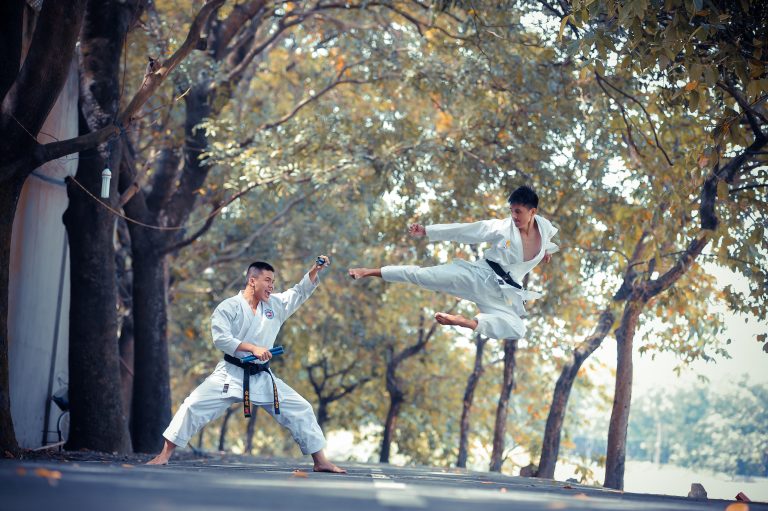Karate-Weiße Gürtel Testanforderungen
Als Karate-Schüler ist es wichtig, sich auf jeden Gürtel-Test vorzubereiten, um sicherzustellen, dass Sie die notwendigen Fähigkeiten und Kenntnisse beherrschen, um Ihren nächsten Karriereschritt machen zu können. Wenn Sie sich für den weißen Gürtel entscheiden, müssen Sie spezifische Fähigkeiten erlernen und nachweisen, bevor Sie den Test bestehen können. In diesem Artikel erläutern wir die wichtigsten Karate-Weiße Gürtel Testanforderungen.
Grundlagen und Theorie
Bevor Sie Ihre Karate-Kenntnisse auf die nächste Stufe bringen können, müssen Sie das Fundament des Sports beherrschen. Während der Vorbereitungszeit für Ihre Prüfung werden Sie aufgefordert, Grundlagen wie Standhaltung, Beinfertigkeit und Schlagtechniken zu erlernen. Sie müssen die notwendige Theorie auch verinnerlichen, einschließlich der grundlegenden Philosophie des Karate und der Geschichte des Sports.
Kata-Übungen
Eine weitere wichtige Fertigkeit, die Sie beherrschen müssen, um den weißen Gürtel-Test zu bestehen, sind die Kata-Übungen. Dies sind choreografierte Bewegungsabläufe, bei denen Sie verschiedene Techniken wie Tritte und Schläge ausführen. Es gibt verschiedene Kata-Übungen für jeden Gürtel, und für den weißen Gürtel müssen Sie mindestens eine Kata beherrschen.
Kihon-Kombinationen
Kihon-Kombinationen sind eine Folge von Techniken, die in einem kontinuierlichen Bewegungsfluss ausgeführt werden. Es ist wichtig, dass Sie Ihre Techniken und Bewegungen präzise und fließend ausführen, um den Test zu bestehen. Für den weißen Gürtel müssen Sie mindestens drei Kihon-Kombinationen lernen und beherrschen.
Kumite-Übungen
Kumite ist der Kampf gegen einen Gegner. Für den weißen Gürtel müssen Sie mindestens eine Kumite-Übung erlernen. Es ist wichtig, dass Sie Ihre Techniken mit einer schnellen Reaktionszeit ausführen und die Fähigkeit beherrschen, Techniken zu blockieren und auszuweichen.
Partner-Übungen
Partner-Übungen werden auch als Kihon-Übungen bezeichnet und sollen Ihnen helfen, Ihre Schlag- und Trittfertigkeiten zu verbessern. Während dieser Übungen lernen Sie, wie man effektiv auf Angriffe reagiert und wie man Techniken blockiert und kontert. Für den weißen Gürtel-Test müssen Sie mindestens eine Partner-Übung lernen und ausführen können.
Fazit
Die Prüfung für den weißen Gürtel ist die erste Stufe in Ihrer Karate-Karriere. Sie müssen in der Lage sein, die Grundlagen des Sports und die Techniken, die für die Prüfung benötigt werden, zu beherrschen. Indem Sie sich auf die oben genannten Anforderungen konzentrieren, können Sie sicherstellen, dass Sie bereit sind, sowohl körperlich als auch geistig für Ihren weißen Gürtel-Test zu bestehen.
Karate-Weiße Gürtel Testanforderungen – FAQs
Karate is a martial art that has been popular for decades. It started as a form of traditional martial arts in Okinawa and later spread throughout the world. Today, karate has become a competitive sport, but it is still rooted in the traditional principles and values of its origins.
In karate, the belt system is used to indicate the rank and skill level of practitioners. The white belt is the first belt in the system, and it is the starting point for all beginners. This article will answer some of the most frequently asked questions about the requirements for the white belt test in karate.
1. What are the basic techniques required for the white belt test?
To pass the white belt test, you need to demonstrate a basic understanding of the fundamental techniques of karate. These include basic kicks, punches, and blocks.
Some common techniques required for the white belt test includes:
- Downward Block (Gedan Barai)
- Straight Punch (Choku Zuki)
- Front Kick (Mae Geri)
- Low Roundhouse Kick (Gedan Mawashi Geri)
In addition to these techniques, you may also be required to demonstrate basic stances, such as the front stance (Zenkutsu Dachi), back stance (Kokutsu Dachi), and horse stance (Kiba Dachi).
2. How do I prepare for the white belt test?
Preparing for the white belt test requires discipline and dedication. You can start by attending regular karate classes to practice and improve your techniques. It is also essential to study and memorize the basic karate terminology, which includes Japanese words for stances, punches, kicks, and blocks.
You should practice your techniques regularly, both in and out of class. Using visualization and breathing techniques can also help you stay calm and focused during the test. Lastly, it is essential to maintain a healthy diet and engage in physical exercise to improve your overall physical fitness and stamina.
3. What should I wear to the white belt test?
You should wear a clean, neat, and traditional karate gi (uniform) to your white belt test. Make sure your gi is properly fitted, ironed, and devoid of any patches or logos. You should also ensure that your belt is tied correctly, with the knot at the side or back, and not in the front.
It is imperative to arrive early for your test to have ample time to change and warm-up. Generally speaking, you should always dress respectfully and modestly when participating in karate.
4. What is the format of the white belt test?
The format of the white belt test may vary depending on your instructor and dojo. It typically involves a combination of basic techniques, katas (pre-arranged patterns of movements), and sparring (kumite).
You may also be required to answer questions about the basic principles and philosophy of karate. Some teachers may also test your physical fitness through drills and exercises.
5. How long does it take to earn a white belt in karate?
The time it takes to earn a white belt in karate depends on the individual’s dedication, discipline, and ability to learn. Typically, it takes about three to six months of regular practice to earn a white belt.
However, it is essential to note that earning a belt in karate is not just about the time you have put in, but also about your technical proficiency and understanding of the martial art.
6. What are the benefits of earning a white belt in karate?
Earning a white belt in karate is a significant achievement and marks the beginning of your journey as a martial artist. The benefits of earning a white belt include:
- Increased self-confidence and self-esteem
- Better physical fitness and stamina
- Improved focus and concentration
- Better discipline and self-control
- Development of positive values and principles, such as respect, humility, and integrity
Conclusion
Earning a white belt in karate may seem like a daunting task, but with dedication and practice, it is attainable. As a beginner, it is essential to focus on developing a strong foundation in the fundamental techniques and principles of the martial art.
Remember to attend regular karate classes, practice your techniques regularly, and maintain a healthy lifestyle to stay physically and mentally fit. Lastly, approach your white belt test with humility and confidence, and don’t forget to enjoy the experience!
Inhaltsverzeichnis






